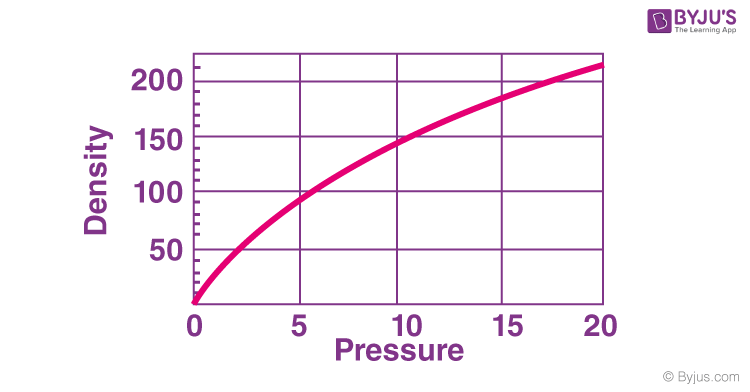Pressure is the measure of force acting on a unit area. Density is the measure of how closely any given entity is packed, or it is the ratio of the mass of the entity to its volume. The relation between pressure and density is direct. Change in pressure will be reflected in a change in density and vice-versa.
Pressure and Density
The pressure and density relationship for ideal gases and fluids is mathematically written as-
| Formula | Terms | SI units | |
| For ideal gas | \(\begin{array}{l}P=\rho RT\end{array} \) |
P is the pressure of the ideal gas | pascal or Pa |
| R is the universal gas constant | R=8.31 J/mole/K0 | ||
| T is the temperature of the ideal gas | Kelvin or K0 | ||
\(\begin{array}{l}\rho\end{array} \) is the density of the ideal gas. |
Kg/m3 | ||
| For fluids | \(\begin{array}{l}P=\frac{\rho Vg}{Ag_{c}}\end{array} \) |
P is the pressure of the fluid | pascal or Pa or bar |
\(\begin{array}{l}\rho\end{array} \) is the density of the fluid |
lbm/ft3 | ||
| V is the volume | ft3 | ||
| A is the area | ft2 | ||
| m is the mass | lbm | ||
| g is the acceleration due to gravity | ft/sec2 | ||
| gc is the gravity constant | 32.17lbm-ft/lbf-sec2 |
Read More: Ideal Gases
Pressure and Density Relationship

The pressure and density relation are direct. That is, the pressure is directly proportional to density. Which means that –
- When pressure increases, density increases.
- When the pressure decreases, density decreases.
- When density increases, pressure increases.
- When density decreases, the pressure decreases.
Pressure and Density Equation
Deriving pressure and density equations is very important to understand the concept. Below is the derivation of pressure and density relation for the ideal gas as well as for fluids.
Equation of State Ideal Gas
In thermodynamics, the relation between pressure and density is expressed through the equation of states for ideal gases. Consider an ideal gas with
- Pressure P
- Volume V
- Density ρ
- Temperature T
- Universal gas constant R
- Number of moles n
Applying Boyle’s law and Charles and Gay-Lussac law we get-
- Boyle’s law: For a given mass, at a constant temperature, the pressure times volume is constant. PV = C1
- Charles and Gay-Lussac law: For a given mass, at constant pressure, the volume is directly proportional to the temperature. V = C2T
Combining both we get-
Specific volume (v) can be defined as the ratio of volume to its mass
Substituting the above equation in equation (1), we get
Rearranging, we get
We know that,
where M = Molar mass, n is the number of moles and m is the mass.
Therefore, equation (2) becomes
Here R is the universal gas constant.
A specific gas constant is equal to the product of molar mass and universal gas constant.
By substituting value of specific gas constant in equation(3) we get,
| Darcy-Weisbach Equation |
| Relation between Kp and Kc |
| Kelvin-Planck Statement |
| Relation between Bar and Pascal |
| Boyle’s Law |
Stay tuned with BYJU’S for more such interesting articles. Also, register to “BYJU’S – The Learning App” for loads of interactive, engaging Physics-related videos and unlimited academic assistance.

Are lb and ft SI units?
No, they are not.